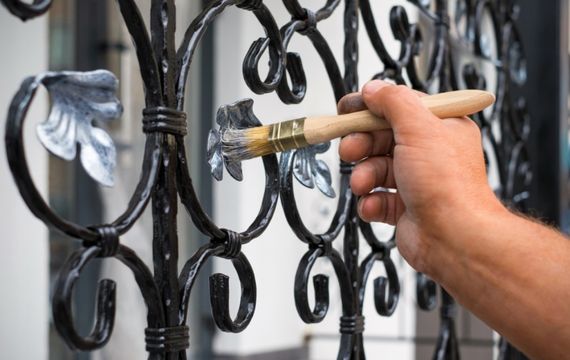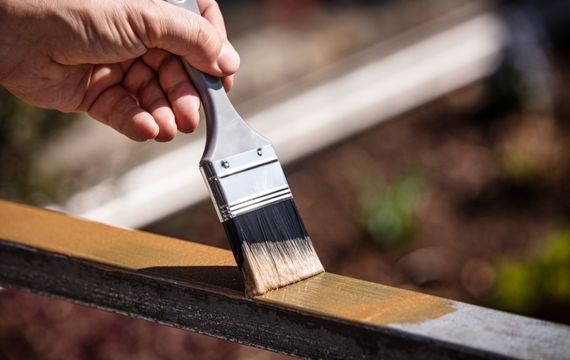
I know you are probably wondering whether enamel paint is good for your metal fabrication projects or not.
If that is the case, then read this guide. It covers everything about enamel paint for metal – from benefits, preparations before painting, uses, and enamel paint classification, just to mention a few.
Let’s dive right in.
What is an Enamel Paint for Metal?
Enamel paint for metals is an oil-based or water-based paint that is used for both interior and exterior applications.
It is glossy, thin, and has protective attributes. In most cases, you can use enamel paint on metals that would otherwise be hard to paint.
Advantages of Using Enamel Paint on Metals

- Smooth surface finish – enamel paints leave the surfaces smooth with no marks or blemishes making them beautiful and protected.
- Resistant to scratches – though possible, it is very difficult to scratch enamel paints
- Permanent gloss – the glossy nature of enamel paints tends not to fade, giving it a resemblance of permanency.
- More vibrant – compared to other paints, enamel paints give the metal surface a more vibrant, glossy look. Even after a long period of use, they maintain this vibrancy and color.
- Fewer brush marks- the thinness and smoothness of the enamel paints do not give room for leaving many brush marks on metal surfaces. It is exemplary for staying even and smooth.
- No yellowing – enamel paints don’t seem to age. They can retain both colorfulness and whiteness in the case of white paints.
- More surface applications- enamel paints can be used to paint different metal surfaces as compared to other paints
- Resistant to heat- enamel paints can be used on surfaces that are used in extreme temperature environments such as fires, ovens, or cold temperatures. Enamel improves the temperature resistance of products it is used on.
As you can see, there are many reason why you should consider painting metal with enamel paint.
Limitations of Using Enamel Paint on Metal
Although this paint offers numerous benefits, there are some reasons why you should avoid it:
Difficulty in Use
It is quite hard to use enamel. Take for example enamel paints have a strong smell, run easily, and are quite challenging to mix properly.
It requires the use of masks and proper experience to paint properly.
Expensive is Slightly Expensive
The biggest setback for enamel painting is the price of the paint. It is more expensive since it has more significance compared to other paints.
Method of Drying
In most cases, enamel paints have to be baked on a metal surface as a means of drying it.
Applying it and letting it dry is not an option. Specialized equipment, which is quite costly, is needed to facilitate drying.
How to Prepare Metal for Enamel Paint

Enamel paints are chemically and mechanically adhesive which makes it easier for them to stick or pass through other materials.
You should prepare the surface to be painted properly to increase its mechanical adhesion to the paint.
First, a 120-grit sandpaper is very instrumental in achieving the much-needed outcome.
Second, you should also make the surface tougher by using some scuffing pads.
Third, once the metal surface is no longer shiny, you can stop scuffing it. Remember, sandpaper is also used to scrape the surface.
A smoother surface is achieved when any dust on the metal is wiped off. The dust will make the enamel paint on the metal surface look uneven and cakey.
Ways to Apply Enamel Paint to Metal
Enamel paints to the metal need to be applied in a particular way to ensure that you get the required results.
A smoother surface finish can be achieved when you use the proper method to apply the paint. To achieve a superb result, you should follow this procedure;

Prepare the Metal Surface
Because enamel paints are mechanically and chemically sticky, it is simpler for them to attach to or penetrate other materials.
To increase the mechanical adherence of the paint to the surface, you should adequately paint the surface.
A 120-grit sandpaper is essential in getting the desired result.
By applying some scuffing pads, you should also make the surface more resilient.
You can cease scratching metal once it has lost its shine.
Apply a Primer on the Metal
Enamel paints are not directly applied on metal surfaces. You need to apply a coating layer of a good quality primer.
The primer has the unique significance of ensuring that the topcoat of the enamel paint is applied on the surface smoothly. Remember, the primer you choose should be a shade of the color you have decided to paint the metal with.
In case the primer you use has a darker undertone than that of the enamel paint, the surface of the metal paint appears to be clumsy.
Choosing a Good Brush
The application of enamel paint on metals requires a good brush. Normally, the correct brush is vital in achieving the surface finish you hope for.
Use the correct quality to apply each stroke evenly and consistently. You should ensure that the tip of the brush is properly covered with enamel paint to apply the paint uniformly.
When the undercoat dries, the strokes of brush used should be invisible.
Using a Sandpaper
The surface can also be scraped with sandpaper. It is possible to obtain a smoother surface by wiping off all of the metal’s dust.
The enamel paint on the metal surface will seem uneven and cakey due to the dust.
Using Painting Tape
Sometimes you might need to use more than one enamel paint color in the process of painting. In such situations, you are advised to use painter’s tape.
The tape can also be used to cover areas where you do not need to apply enamel paint. It also ensures the cleanliness of the parts you do not want to paint.
Lay Down a Drop Cloth or Sheet on the Ground
A drop cloth used here can be any piece of clothing, an old bedsheet, or a plastic sheet. You should tape it down properly on the ground and itself to avoid any accidents and tripping. The drop cloth is used to simplify the post-clean-up process of enamel paints.
Applying the Undercoat
You can apply the first coat of the enamel coat. The undercoat is expected to be very light.
It creates a substantive color base upon which you will reply to the subsequent layers.
Applying the Topcoat
Once the undercoat has dried up, you can now apply the subsequent paint coats. Applying the subsequent coats of enamel paint before the previous layer dries up, risks smearing the enamel paint.
Removing the Tapes
Before the paint can dry up, make sure you remove the tape you put on the metal and any that may get stuck while removing them. Waiting for the paint to dry before removing the tape, might result in chipping parts of the painted surface off.

Types of Metal Enamel Paints
At the moment, you can choose from the numerous enamel paints available in the market.
- Oil Based Enamel Paint for Metals
- Industrial Enamel Paint for Metals
- Enamel Spray Paint for Metals
- High Resistance Enamel Paint for Metals
- Water-based enamel paint for metals
How to Choose the Best Enamel Paint for Metal
There are many factors that you must consider to choose the best paint to use for your project.
Such considerations may be;

Available Budget
Metal enamel paints vary in price due to the variety of paint brands and the quality of paint you need.
The budget that is at your disposal will determine the quality of paint you will choose. High-quality paints can be quite expensive while those with cheap pricing might mess up the quality of your project.
Area of Application
The environment in which you want to paint the metal, plays a critical role in the type of paint you want to use.
The outdoor application will require oil-based metal paint for durability purposes and water resistance.
Method of Painting
You should choose your type of paint depending on the method you will use to paint the metal.
You may require to spray or brush. It mostly depends on the quantity of work you want to paint.
Specific Qualities of the Paint Needed
Extreme conditions such as heat and moisture determine the specific qualities that the metal paint to be used must have.
The metal enamel paint you choose must have the characteristics needed to withstand the environment it is used in.
The Surface Finish you Intend to Achieve
You may need a Glossy, Matte Flat, or Satin Surface Finish. Different metal paints have different surface finishes.
The type of finish will also depend on the thickness of the paint, the type of metal in use, and whether you use the primer or not.
Uses of Enamel Paints in Metal Fabrication

You can use this paint on many surface such as:
- Appliances such as dryers, washers, tubs, fridges, and sinks.
- Outdoor grills for decoration and protection purposes.
- Metallic door painting to make them more vibrant and strengthen them.
- Refinishing dishes to brighten them up.
- Model figures such as trains, cars, and planes create aesthetic value in the designs.
FAQs
Do Metal Enamel Paints Require Primer?
No, not all painting applications require primer.
Primer is only used when;
- Surface porosity is a concerning factor
- Surface adhesion to the paint to stick is in question
- Visibility of the stain underneath the surface finish might be needed.
Primer helps in ensuring that you achieve whatever result you expect.
Are There Spray Enamel Paint for Metals?
Yes, spray enamel paints for metals are available.
They work similarly to standard enamel paint that is applied using brushes.
With spray enamel paints, brush marks that would be left on the metal surface are eliminated.
When applying spray enamel paints, you should be keen to watch for bubbles that the spray might leave behind.
Is Enamel Painting Metal Durable?
Yes, enamel painting for metal is durable.
Enamel painting gives the metal a hard, glossy, and polished surface that is long-lasting.
Conclusion
As you can see, enamel paint plays an integral role when painting fabricated metal parts.
At KDM, we use the best grade of enamel paint for surface finishing.
More Resources:
Best Paint for Metals – Source: Thomas Net
How to Paint Enamel on Metal – Source: Hunker
Enamel Paint – Source: Wikipedia
Painting with Enamel on Metal – Source: eHow




